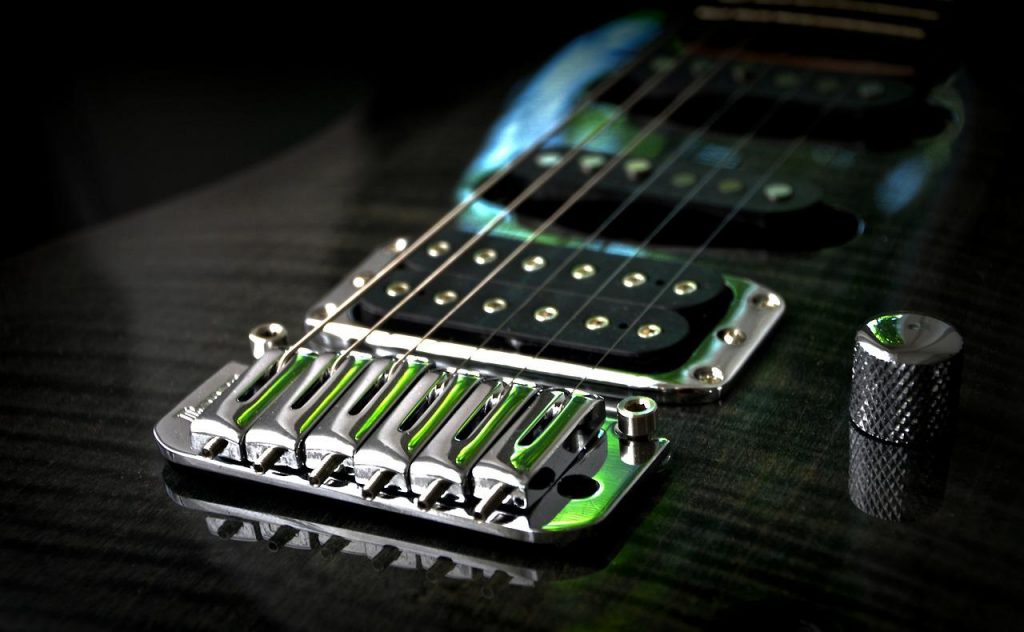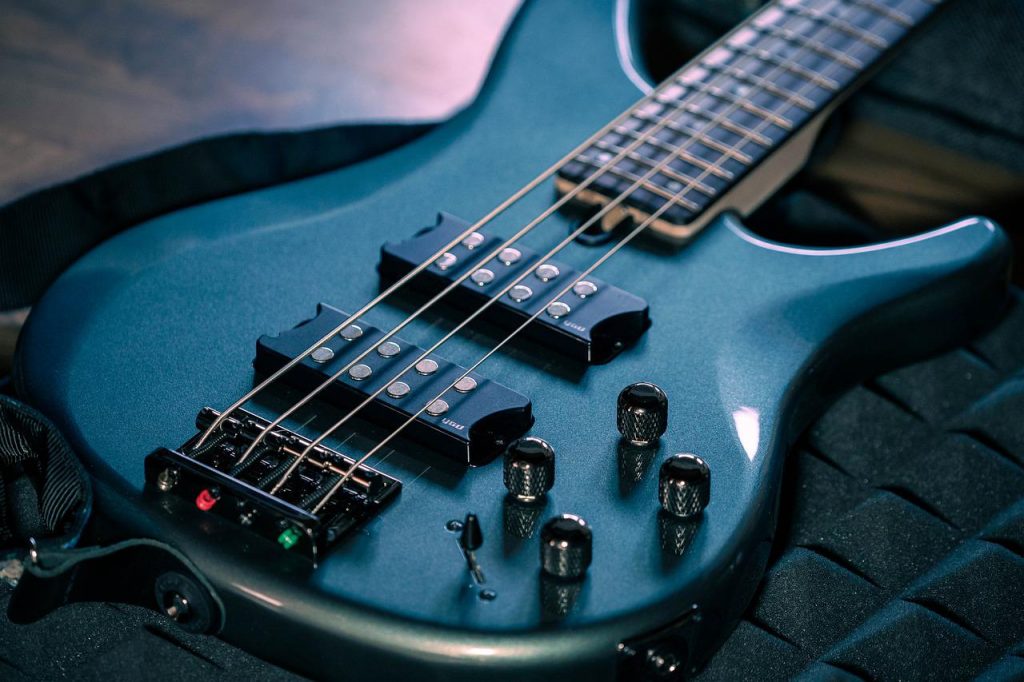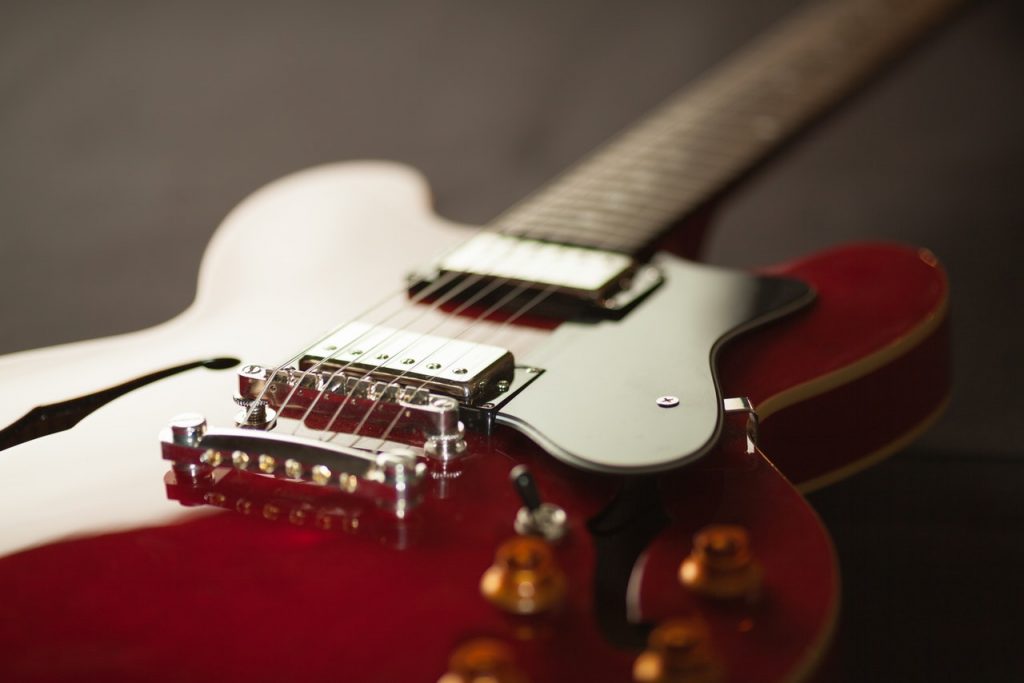Do you know what a hardtail guitar is? It’s an electric guitar that provides the same great sound as other electric guitars but without the vibrato system.
Hardtail guitars are popular among many different types of musicians and can be found in just about any genre from classic rock to metal.
In this article, we’ll take a look at what makes a hardtail guitar unique and why it might be the right choice for your playing style.
What does hardtail mean on guitar?
A hardtail guitar is made out of hardware that joins the strings at or below the bridge and is fastened to the front of the instrument’s body. It was designed for electric guitars and also archtop guitars.
Electric guitars have bridges, and the bridge of an electric guitar has a considerable impact on their overall sound and usability. The hardtail bridge is the most often-seen form of guitar bridge in the world of guitars.
If you compare hardtail electric guitar bridges to many other tremolo bridges on the marketplace, you will find that they are simpler, firmer, and more durable to use.
Why is it called a hardtail?
The name of the hardtail guitar comes from its unique design; it is crafted without a vibrato tailpiece, which is commonly found on electric guitars. This allows for the strings to be anchored directly to the bridge of the instrument, creating a hard point and tone that is unlike any other type of guitar.
Unlike a vibrato bridge which relies on springs to provide tension, the hardtail design prevents any give or movement within the strings, allowing for an incredibly tight sound.
Hardtail guitars are popular amongst musicians because they can offer a variety of tones depending on how they’re strung and tuned. The lack of movement in the strings can mean that harder string gauges are used for increased sustain and clarity, as well as lighter gauge strings for a more defined yet mellow tone.
Furthermore, due to its construction, this type of guitar can even serve as an acoustic-electric hybrid with pickups designed to capture both tones – ideal for live performance situations.
What are the pros and cons of hardtails?
Firstly, they can offer a wide range of tonal options depending on the string gauge and tuning used. The hardtail design prevents any give or movement within the strings, providing an incredibly tight sound with increased sustain and clarity.
Additionally, hardtails tend to be relatively low maintenance since there are no springs or other delicate components that may need servicing or replacing over time.
On the other hand, there are some potential drawbacks associated with this type of guitar.
Firstly, due to its design, the string tension is always high regardless if you tune it up or down; meaning that it can be uncomfortable for some people to play due to its tightness.
Secondly, because of its lack of a vibrato tailpiece, you won’t be able to do traditional bends when playing on a hardtail guitar.
Finally, hardtail guitars tend to cost more than their traditional counterparts because of their unique construction and complex electronics.
Overall though, the pros of hardtail guitars far outweigh the cons – making them an excellent option for those looking for an instrument that offers a wide range of tones and versatility in a single package!
How do you set up a hardtail guitar?
Setting up a hardtail guitar requires some preparation and patience.
First, the player should decide on what string gauge they would like to use. Heavier gauges offer increased sustain and clarity, while lighter gauges provide a more mellow sound.
Once the strings are chosen, the player will need to tune their guitar by winding each string around its respective tuning peg until it reaches the desired pitch.
The next step is to adjust the intonation of the instrument, which is done by adjusting the bridge saddle on each string so that it produces an in-tune note when struck at the 12th fret harmonic.
After adjusting the saddle height and intonation, players can then adjust their pickups for optimal volume and tone. Finally, all parts must be secured so that no rattling or movement occurs during play.
A great way to ensure a proper setup is to have a professional technician give your hardtail guitar an inspection and initial tuning. This will ensure that all components are properly set up and functioning as they should be before you start playing your instrument.
With regular maintenance, proper setup, and care, your hardtail guitar will provide years of reliable performance and beautiful tones!
| Step | Description |
|---|---|
| 1 | Loosen the strings by turning the tuning keys counterclockwise. |
| 2 | Remove the old strings from the guitar. |
| 3 | Clean the fretboard and body of the guitar with a soft, lint-free cloth. |
| 4 | Adjust the truss rod if necessary. Use a hex key to turn the truss rod nut clockwise to straighten the neck or counterclockwise to add some relief. |
| 5 | Adjust the string action. Use a feeler gauge to measure the distance between the bottom of the strings and the top of the frets at the 12th fret. Adjust the saddle height screws until the strings are at the desired height. |
| 6 | Check the intonation. Use a guitar tuner to check the tuning at the 12th fret. Adjust the saddle position to achieve accurate tuning. |
| 7 | Lubricate the nut and bridge saddles with graphite to reduce friction and improve tuning stability. |
| 8 | Install new strings on the guitar. |
| 9 | Tune the guitar to pitch and stretch the strings to help them settle in. |
| 10 | Check the tuning and adjust as needed. |
| 11 | Test play the guitar to ensure the action, intonation, and tuning are all correct. |
| 12 | Make any final adjustments as needed. |
| 13 | Enjoy playing your newly set up hardtail guitar! |
How do you string a hardtail bridge?
Stringing a hardtail bridge requires patience and attention to detail. To begin, one must select the right strings for the guitar. Heavier gauge strings produce more sustain and clarity while lighter gauges provide a mellow tone.
Once the strings are chosen, they must be wound around their respective tuning pegs until they reach the desired pitch.
The bridge saddle is then adjusted on each string so that it produces an in-tune note when struck at the 12th fret harmonic. This is done by adjusting the distance between the string and saddle until both pieces are parallel with each other.
After this step is complete, playability should be ensured before moving further into the setup process.
Players may also adjust their pickups for optimal volume and tone by adjusting the height of each pickup’s pole pieces until preferred settings are reached. Finally, all parts must be secured to ensure that no rattling or movement occurs during play.
Overall, setting up a hardtail guitar can be an involved process, but with patience and attention to detail, the results can be incredibly rewarding!
Do you need locking tuners on a hardtail bridge?
Locking tuners are not necessary for a hardtail bridge, as the strings will remain anchored to the bridge and in tune due to the lack of a vibrato tailpiece.
That said, some players may still opt to install locking tuners on their hardtail guitar if they want increased tuning stability and faster string changes.
These types of tuners will hold the strings in place through tension rather than friction, meaning that less time is lost when changing strings or making adjustments.
Additionally, they can help prevent any rattling or buzzing caused by movement between two moving parts which can occur with traditional open-gear tuners.
However, it’s important to note that these features come at an additional cost and require specialized installation – so keep this in mind before deciding to add locking tuners to your instrument.
How can I make my hardtail better?
There are a few ways to make your hardtail guitar better.
Firstly, you can upgrade your strings to higher quality ones that offer increased sustain and clarity. Heavier string gauges produce more volume and punch while lighter gauges provide a mellow tone.
Moreover, pickups can be adjusted for optimal volume and tone by adjusting the height of each pickup’s pole pieces until preferred settings are reached.
Lastly, lubricating any friction points between any moving parts with a small amount of graphite or similar material can reduce noise levels and wear rates over time.
By making these simple adjustments your hardtail guitar will sound better than ever before!
How to choose the right hardtail guide for you?
Over the years, guitar makers have experimented with a variety of different hardtail bridge designs. Many diverse types of bridges exist, but the vast majority of them fit into one of three general categories. We’ve included a few different sorts of guitars that are sure to suit your needs below.
The Fender Hardtail Bridge
The Fender hardtail bridge is the most well-known and widely used type of hardtail electric guitar bridge in the world. In 1950, Fender created the “Broadcaster” (later known as the Telecaster) as the first guitar with this form of bridge. Since then, Fender and other manufacturers have continued to develop versions of this design in various sizes and configurations.
They are made out of a flat base plate which is bent vertically at the rear to form the bridge. On the bottom of the base plate are either three or six-string saddles, each having a height adjustment screw for each string. Screws for tuning the instrument’s intonation are located at the rear of the saddles and run up the vertical section of the base plate.
The Tune-a-Matic Bridge
Ted McCarty, while working for Gibson in the 1950s, came up with the idea for the Tune-a-Matic bridge and implemented it. Originally released in 1953, Gibson’s unique design has subsequently found its way onto nearly all of the company’s electric guitar models, including the Strat and the Telecaster.
For the tailpiece to function, it must be made of metal and have six holes bored in it from front to back. This tailpiece is attached to the guitar body through two hefty studs at either end, which are screwed into the body of the instrument. The tailpiece is located behind the bridge and serves as a point of attachment for the strings.
The Wraparound Bridges
This is the last type of hardtail bridge that we’ll discuss today: the wraparound bridge. A Tune-a-Matic type tailpiece was the only component of the original bridges, which had been built in the 1950s. The strings were routed into the front of this bridge/tailpiece and then wrapped over the top of it in the direction of the tuning machines.
Early wraparound bridges did not allow for the modification of individual intonation or height settings for the strings. The overall height of the bridge may be adjusted by screwing in or out the mounting studs of the bridge.
Bottom Line
Now you know what is a hardtail guitar. In a nutshell, a hardtail guitar is an electric guitar that has a bridge fixed to the body of the instrument, as opposed to a tremolo bridge. Hardtail bridges provide greater tuning stability and require less maintenance than tremolo bridges, but they do not allow for the same range of expressive techniques.





